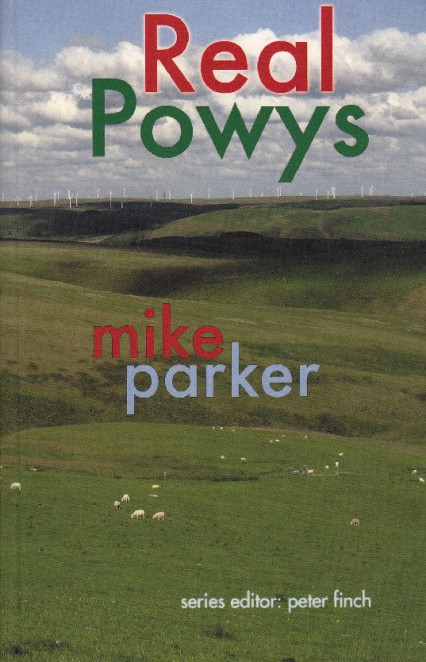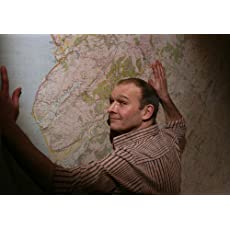Adam Somerset goes in search of Real Powys in his review of Mike Parker’s latest book, and asks the bigger question, what is “Real”?
From the cliff road between Llanon and Aberaeron the coast of Ceredigion can be seen in its entirety, Dyfi estuary to Cardigan Island. Powys, as seen from the West, has one feature that dominates; its sheer scale. At Llangurig, a dozen miles in where the Wye is still so small it can almost be jumped over, the road divides. Turn left and Powys reaches as far as the Dee, a half hour’s drive from Chester. Turn right and it laps the Heads of the Valleys road. It’s a great, empty, paradoxical county, home to folkies, face painters and the BNP. The rail station for Knighton, Mike Parker tells us, is located in England.
Mike Parker, in the fourteenth of Peter Finch’s series for Seren, travels to every corner. He relishes a perfectly toasted tea cake in Presteigne’s Radnorshire Arms. He sees conference delegates buffeting in Llandrindod’s mighty Metropole. Llandod itself, reports a spikey footnote, has the County’s worst unemployment rate. He admires the marvellously jumbled architecture of Llansantffraid-

by Mike Parker
200pp, Seren, £9.99
Real Powys starts with an idiosyncratic flourish. Give Powys a check-
The “Real Wales” series are not history; it intrudes, but lightly. The Rebecca Riots storm through Rhayader. When the Elan Valley is flooded, the eighteen dispossessed farmers happily are tenants so no compensation is required. He touches on many of the figures of history, ancient and modern. The Davies dynasty is not present other than a mention of the railway cutting off Derwenlas’ access to the sea. But Glyndwr, Humphrey Lluyd, Reverend Kilvert, Adelina Patti, Clement Davies, Eric Gill, John Piper, Bruce Chatwin, and Richard Booth are all here. The last provides a bilious comment on the Development Board for Rural Wales.
Every book in the “Real…” series blends the personal and factual. Real Powys is threaded with a larger than usual measure of autobiography. There is a continuity with the earlier writings, the authorship of the “Rough Guide”, the tussling with Wales’ paid promoters and the drippy view of Wales they wish to promulgate. Mike Parker is always an enthusiastic witness, with his camper van, his relish for a good beer, his sheer devotion to a place where he has found home.
On a youthful visit he admits to being scared of Builth, with its burly farmers and Ifor Williams trailers crammed with livestock. But he learns to love the town. He goes touring in a production of an Alan Bennett play. His delight at being at Churchstoke’s tatterdemalion market is quite physical. A café with a new coffee machine has a handwritten sign “For Milky Coffee press Café Latte”. He talks magic mushrooms. At a rave near Abergwesyn he has a timid, youthful romantic encounter. The older and wiser Parker cannot but help admire the “drive and commitment” of Tiggy Legge-
Behind the affection there is a sense of sadness for the uncertainty of this great rural space. Llanymynech’s Lion Hotel, with its two bars straddling the border, is empty and boarded up. Machynlleth’s remorseless Tesco wars draws out three camps in the town, who live more or less independently of each other. Llangammarch’s barium chloride pump room is a ruin inaccessible after the demolition of a footbridge. Farmer Derek has four children and not one wants the farm. From the slopes of Pumlumon a tenth of Britain’s total wind turbines are visible.
Each book in the “Real…” series is as interesting as the personality which runs through it. Among the thirty plus reasons for road delays are “Ian Botham on a charity walk” and “the bloke who wheels a large cross most Easters.” He finds secret places I have noted. Newtown is given a hard time. It’s not the Newtown of my experience. La Terrazza does a terrific tagliatelle. Charlies is unique. A browse around Fuze always yields something to surprise. Miles of greenery run alongside the Severn. And it is home to a company which serves up unfailingly imaginative opera.
But a good travel writer has personality. The soothing balm of the tourist industry is not his. Mike Parker possesses the depthless curiosity of the good journalist and the industry of the professional writer. Of Montgomery: “there is nowhere quite as winsome.” As for the town that is “calm, urbane, well-
You might also like…
As a result of local travel restrictions and limitations on time spent outside of our homes, many of us have recently grown to appreciate the beauty of nature more than ever before. Here, Gareth Smith reviews The Owl House by Daniel Butler, an informative and immersive documentation of the nature surrounding the author’s mid-Wales home.
Adam Somerset is a frequent contributor to Wales Arts Review.











